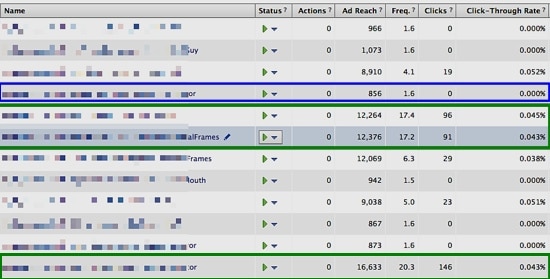Welcome to the first installment of AIMCLEAR‘s Facebook Philosophies and Best Practices Guide. In these posts we’ll outline Facebook Ads best practices from account structure and psychographic targeting to ad creation and ad management. Our goal is to offer essential thinking in bite size chunks. In this first post we’re highlighting how to best set up your Facebook Ads account structure. Though seemingly basic, very few accounts we evaluate come our way pre-wired with coherent structure in place.
Keep It Organized!
Most online advertisers are familiar with AdWords and AdCenter and the concept of campaigns, adgroups, and ads, however, with Facebook ads manager there are only campaigns and ads.
Facebook Ads Best Practice: Treat Facebook campaigns as adgroups
That means: all ads within a campaign are targeted the same.
Why You Should Care:
OK, you may only be testing Facebook ads, but no matter, set yourself up for success (see reason #2 below) and spare yourself some headaches!
In-campaign ad competition
This is pretty important, so tune-in! The folks over at Facebook are not dummies; they understand the fastest way they’re going to get paid is to show the ads that are receiving clicks more than the others. This makes total sense! However, there are flaws in the system and the logic:
- Facebook decides which ad(s) are better than others within the same campaign after receiving ONE hour of data. That’s not a whole lot of time…
- Facebook ads are not Search ads (surprised?). You will likely not create a Facebook ad that will consistently be your top ad all the time. Facebook ads decay after a (short!) time, therefore it’s not about optimizing for the best-performing ad but have a couple great performing ads that you can rotate and keep fresh for your audience.
The screen shot shows ads within a campaign after they had all been on. Notice how Facebook’s optimizing algorithm delivers ads that gained clicks early on much more than ones that did not. This does not mean those ads which did not receive a click early on are bad ads. In fact, if the fourth ad from the top was actually shown and received just one click it would have the best CTR of the bunch!
Don’t let this algorithm control which of your ads get served! Manually rotate ads by pausing some ads, and activating others. When rotating ads, activate ads that have similar CTR, with identical (or very similar) bids so one doesn’t out-rank the other in the algorithm.
Evaluating creative
Treating Facebook campaigns as adgroups not only ensures your differently-targeted ads will not be competing against one another, but will also allow you to easily evaluate at a campaign level which ads work for that targeting without pulling & crunching the data. (If you really, really want to crunch that data even further here’s a guide to Facebook reporting which includes creative analysis across campaigns.)
Let’s be clear, evaluating the creative does not lead to using only that creative forever, rather, use this to glean insight on what that specific target market responds to in ads and learn from it. What type of headline got clicked on most? Did the blind (no brand mention) ad intrigue users more than ads that were branded? Did the image of the product work better than the images that featured faces?
Lastly, having all ads in one campaign targeted the same, simply creates a nice level of organization that online advertisers are used to, that does not exist in Facebook’s current structure.










